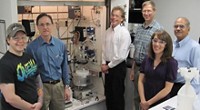Advertisement
Grab your lab coat. Let's get started
Welcome!
Welcome!
Create an account below to get 6 C&EN articles per month, receive newsletters and more - all free.
It seems this is your first time logging in online. Please enter the following information to continue.
As an ACS member you automatically get access to this site. All we need is few more details to create your reading experience.
Not you? Sign in with a different account.
Not you? Sign in with a different account.
ERROR 1
ERROR 1
ERROR 2
ERROR 2
ERROR 2
ERROR 2
ERROR 2
Password and Confirm password must match.
If you have an ACS member number, please enter it here so we can link this account to your membership. (optional)
ERROR 2
ACS values your privacy. By submitting your information, you are gaining access to C&EN and subscribing to our weekly newsletter. We use the information you provide to make your reading experience better, and we will never sell your data to third party members.
Business
Chemistry Reduces Unhealthy Vapors From Wood Composites
Makers of resin used in particleboards and other composites offer competing ways to reduce formaldehyde emissions
by Alexander H. Tullo
August 12, 2013
| A version of this story appeared in
Volume 91, Issue 32

As if it wasn’t enough to have their homes inundated, possessions destroyed, and lives uprooted, Gulf Coast evacuees of 2005’s Hurricane Katrina had to endure another indignity: The trailers given to them by the Federal Emergency Management Agency for safe shelter made them sick.
Trailer interiors used composite woods, and the urea-formaldehyde resins that bound those composites were emitting formaldehyde into the air inside. In 2008, the Centers for Disease Control & Prevention tested the trailers and found formaldehyde levels of up to 590 ppb, which is several times the limit deemed acceptable by the Environmental Protection Agency.
A petition put together by the Sierra Club and signed by many evacuees described some of the symptoms. “Their lungs burn. Their eyes tear,” it read. “Many suffer from headaches and other illnesses that have required frequent doctor visits and, in some cases, hospitalization.”
The episode highlighted the long-standing issue of formaldehyde emissions in the wood composite industry. Producers of the composites, as well as the chemical makers that supply them with binders, have been trying to reduce formaldehyde levels for decades. The sector has also gotten a push from EPA and the California Air Resources Board (CARB), which are putting limits on emissions from wood composite products such as medium-density fiberboard (MDF) and particleboard.
Makers of methylene diphenyl diisocyanate (MDI), a chemical used in polyurethane foam insulation, are pushing this chemical as a healthy alternative. But urea-formaldehyde suppliers aren’t about to let another material poach their business. They say they have already improved their chemistry enough to meet the regulations.
Wood composite production involves coating wood chips, fibers, and particles with a resin and forming a mat, which is then compressed between two plates and cured with heat. The resulting product is cut into boards that are fabricated into finished products such as cabinetry.
Urea-formaldehyde is the dominant resin in MDF and particleboard. The chemistry has been around for a century. The resins are inexpensive and cure at low temperatures. Wood products made with them have smooth finishes and are easy to machine, paint, and laminate.
“The real problem with urea-formaldehyde is that when it gets exposed to higher moisture and temperature conditions, the polymer comes apart,” says Charles R. Frihart, a research chemist with the Department of Agriculture’s Forest Products Laboratory. Gulf Coast heat and humidity may have contributed to the high formaldehyde emissions levels, he notes.
More than just an irritant, formaldehyde has been classified as a known carcinogen. Thus EPA and CARB have been stepping up regulation of formaldehyde emissions. In 2011, CARB set emissions limits of 90 ppb for particleboard and 110 ppb for MDF. In May, EPA proposed similar nationwide caps.
Makers of MDI see a replacement opportunity. MDI reacts with the moisture in wood to create a polymer adhesive. “MDI on its own is the perfect binder for wood,” says Timothy J. Shrewsburg, marketing and business development manager for wood products at BASF.
Over the past decade, MDI has been replacing another resin, phenol-formaldehyde, in oriented strand board, capturing more than half of the market, according to Gregory J. Lonc, BASF’s business manager for rigid urethanes. Emissions aren’t considered a problem with either product, since the monomers in both are locked together tightly. Rather, the shift has been economic. MDI is more expensive than phenol-formaldehyde by weight. However, processors can use less MDI, and the isocyanate cures more quickly and at lower temperatures.
MDI suppliers now want to replace urea-formaldehyde in MDF and particleboard. “There we compete because we don’t have any added formaldehyde in our product,” says Michael F. Adams, commercial director for Huntsman Corp.’s polyurethanes unit.
In addition to improved emissions, MDI producers say, their product offers a moisture resistance advantage over urea-formaldehyde. And even though urea-formaldehyde is less expensive and cures at relatively low temperatures, MDI makers claim an applied cost advantage in some cases as well.
Hold it right there, say urea-formaldehyde makers. Their products have improved so much over the years that switching isn’t necessary, according to Steven Sauter, North American business director for MDF and particleboard resins at Momentive Specialty Chemicals, the world’s largest urea-formaldehyde maker. “We have been proactively working on reducing emissions since the 1980s,” he says.
The company has accomplished this, he says, by modifying the way it polymerizes the resin, tightening production controls, using additives such as formaldehyde scavengers, and using ammonium sulfate and other catalysts. As a result, Sauter says, Momentive has been able to reduce the ratio of moles of formaldehyde to urea in the resin from 1.3 in the 1980s to less than 1.0. “Emissions levels have been reduced to just above that of natural or solid wood,” he claims.
Customers using urea-formaldehyde are already meeting the EPA and CARB emissions requirements, Sauter says. Consequently, even after wood processors geared up for the regulations, urea-formaldehyde’s share of the MDF and particleboard markets is still a lofty 85%, he says.
Frihart agrees that urea-formaldehyde suppliers have been able to improve their formulations and will remain a market force for a long time. “Certainly, you can’t say that urea-formaldehyde is going out of existence,” he says.





Join the conversation
Contact the reporter
Submit a Letter to the Editor for publication
Engage with us on Twitter